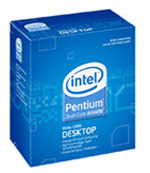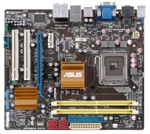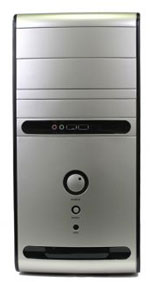Intel Entry-level PC
Intel still owns the pole position in CPU performance, but the area from entry to upper midrange is very competitive between Intel and AMD. In fact, as pointed out in the recent Phenom II Buyers' Guide, AMD is often the better value in the broad midrange category. The only area still dominated by Intel is the very top, where CPUs cost $280 and more.
The one advantage that remains for Intel is that their processors generally overclock better than current AMD CPUs. That has changed with Phenom II in the midrange, but most of today's entry AMD processors still use older designs that do not overclock as well as Intel choices. Overclocking is not normally a consideration in entry computers, but it could be for some buyers, and at the lowest rungs of the CPU ladder Intel processors remain the best overclockers for now.
| Intel Entry-level PC | ||
| Hardware | Component | Price |
| Processor | Intel Pentium Dual-Core E5200 Wolfdale (Dual-core 2.5GHz, 45nm, 65W, 2MB shared L2, 800FSB) | $70 |
| Cooling | CPU Retail HSF | - |
| Video | On-Board | - |
| Motherboard | ASUS P5QL-CM G43 HMDI uATX | $80 |
| Memory | Patriot Viper Model PVS24G6400LLK 4GB DDR2-800 4-4-4 ($52 less $25 Rebate) | $27 |
| Hard Drive | WD Caviar GP WD5000AACS 500GB | $55 |
| Optical Drive | Sony Optiarc Model AD-7240S-OB 24X DVDRW SATA | $24 |
| Audio | On-Board | - |
| Case | SIGMA La Vie LBYWBP Leather Mid-Tower w/ 500W PSU ($65 less $20 Rebate) | $45 |
| Power Supply | 500W Included with Case | - |
| Base System Total | $301 | |
| Display | Acer X193W+BD 19" 5ms Widescreen LCD (1680x1050) | $110 |
| Speakers | Cyber Acoustics CA3090WB 2.1 Gaming Speakers | $16 |
| Input | Microsoft CA9-00001 PS/2 Keyboard and Optical Mouse | $17 |
| Operating System | Microsoft Vista Home Premium SP1 (for System Builders) | $99 |
| Complete System Bottom Line | $543 | |
 |
Our choice for the Intel entry CPU remains the excellent 2.5GHz dual-core E5200 Wolfdale. This 65W rated CPU is built on Intel's 45nm manufacturing that begs you to overclock. The E5200 uses a default 800FSB, so right out of the box the first option for overclocking, if you are so inclined, is to bump it up to 1066 bus. That will give you a 33% overclock and a final speed of 3.33GHz, and it is readily attainable with proper cooling. Even if you never overclock you will be very pleased with the performance of the E5200.
The E5200 is an easier choice now that the price has dropped from $83 a few months ago to $70 today. We do not recommend going lower than an E5200 in an Intel system because the trade-offs in performance for the few dollars saved are too great. The performance of the E1200 at $50, for example, is dismal compared to the E5200, and certainly not a good choice in performance for the $20 saved. The only drawback to this processor choice is the lack of Intel's Virtualization Technology (Intel VT). If running the Windows Virtual PC under Windows 7 for XP Mode (as one example) is important to you, then moving up to the E8x00 range or down to the E6x00 allow the best VT options in this range, although this budget point is no longer valid.
Unlike the numerous AMD product choices in the $60~$80 price range that feature current chipsets and loads of features, the Intel selections are mostly limited to older chipsets like the G31 or NVIDIA GeForce 7100 series. These chipsets are stable, well supported, and are valid options for basic entry-level systems. Intel is promoting the G41 chipset into this price range now and we seriously considered a couple of very good G41 boards, but they featured VGA output or the storage options were limited due to the ICH7 for the type of system we had in mind. Fortunately, ASUS came through with some timely price reductions on their G43 based ASUS P5QPL-CM motherboard and it was an easy decision to choose this particular board for our budget based system.
 |
The P5QL-CM features the latest G43 GMCH along with the ICH10 Southbridge. The GMA X4500 graphics engine does not feature the hardware accelerated H.264/VC-1/MPEG2 decoding capability of the G45 or NVIDIA GeForce 9300 chipsets, but HD video playback is acceptable with a decent processor like the E5200. Otherwise, the performance of the G43 is fine for SOHO applications, flash-based games, and general video duties. However, insert a discrete video card like the HD 4770 and any weaknesses of the G43 chipset go away in an instant.
The P5QL-CM features support for the latest Core 2 Duo, Core 2 Quad, and Pentium/Celeron dual-core processors along with 8GB memory support. The board has a very good layout with one PCIe x16 slot, one PCIe x1 slot, and two PCI slots. The ICH10 does not support RAID but does provide six SATA 3Gb/s ports, one IDE port, and twelve USB 2.0 ports. ASUS includes the 8-channel VT1708B HD audio codec, Realtek RTL8111B Gigabit LAN, and DisplayPort, DVI-D, and VGA video out ports. ASUS based this motherboard on the uATX form factor and it includes a basic accessory kit along with several ASUS specific software applications. The board has proven to be very stable and problem free over the last 30 days. It is not an overclocking demon with our E5200/E7200 being limited to the 345FSB range due to the chipset, but that is more than enough headroom (4.16GHz with the E5200) for most users.
 |
The case and power supply choice are the same Sigma La Vie 500W Mid Tower chosen for the AMD entry system. At a final price of $45 for this good-looking, side-window case and Sigma 500W power supply it is a value that is hard to pass up. If you prefer a smaller Micro ATX case, the HEC 6K28BSOH48D mini tower is a good alternative. HEC is best known as a manufacturer of power supplies. Some are sold under their own name, but most are manufactured for other well known power supply brands. HEC includes a 485W PSU with this attractive mini tower, which should provide plenty of power for your entry build.
Other components are the same ones chosen for the AMD Entry system. Some readers will also notice that our link for the Windows Vista Home Premium System Builders OS is for the 64-bit version. Whether you choose 64-bit or 32-bit, the price of Vista is the same. The choice is yours, but you will need the 64-bit version to fully use the 4GB or more system memory. While 64-bit has made giant strides in drive and component compatibility, if you have an old printer or other peripherals you want to bring from Windows XP to Vista you need to check compatibility very carefully. 32-bit Vista generally works with almost anything that worked with Windows XP, but that is not always true of 64-bit. If you are starting fresh, we recommend choosing 64-bit Vista.
If we compare the two entry-level systems, the winner depends on what is of more value to you. The Intel system is a bit more powerful, but you can move up to a high-end Athlon X2 or a low-end AMD Phenom II X3 for comparable performance at less than $85. If you are an overclocker, the Intel entry may be your best choice. For a gamer, the AMD offers more flexibility for future expansion. For the typical entry-level PC right now and for what the system typically is used for - internet, office, low-end gaming, and low to mid graphics - you can go either route and be very happy.










65 Comments
View All Comments
Wesley Fink - Thursday, May 14, 2009 - link
That is the way it is on the Intel side. We have to go up to the $169+ range to get VT on Intel and quite frankly, maybe 1% of people might ever run XP mode in Win7.If running the Windows Virtual PC under Windows 7 for XP Mode is important to you, then moving to the E8x00 range or the E6x00 are the best VT options. That would blow the Budget out the door, and make the Intel selections not competitive in the Budget Range.
Do you work for AMD? This is a really minor nag for the vast majority of our readers, and as I'm sure you aware, for a Budget PC if this feature really matters to you then go for an AMD system in the budget price range.
nycromes - Thursday, May 14, 2009 - link
I think their point was/is that there is no mention of it in the article. It is nice to know what you get and what you don't get for these kind of systems. I don't think many will need the VT feature, but it could have still been presented in the article for those that might need it. I wouldn't change the recommendations, but just a small blurb about it would probably suffice.Of course, if they read the comments, there is plenty of mention of it so it doesn't really matter anymore.
Gary Key - Thursday, May 14, 2009 - link
We had strict budget numbers to meet for this guide. We had to select the entry level Intel processors due to cost and still provide a decent set of components around it. We added a statement about VT support to the processor descriptions.HelToupee - Thursday, May 14, 2009 - link
This will be a boon to those using non-Microsoft OSes for our HTPC's XBMC, my HTPC OS of choice has supported nVidia's accelerated video playback for quite awhile now. Unfortunately, players have not been able to take advantage of AMD/ATI's Linux drivers due to AMD/ATI being slow to release specs/headers. Acelleration on nVidia is supported in most major Linux video players by default, all you have to do is have the nVidia binary driver installed.kleinwl - Thursday, May 14, 2009 - link
It's probably worth mentioning that a core i7 makes a great cpu in an HTPC. While it blows the budget, if you are looking to upscale DVDs using ffdshow (or the like) to fit your 52" screen, I would suggest that you do not skimp on the cpu power. While ffdshow is a nightmare to get properly configured (thousands of options, no consistent recommendations), once you do, you can have a viewing experience close to that of an oppo. However, ffdshow can be a resource hog, and thus I recommend pushing the cpu spec as high as you can aford.Spoelie - Friday, May 15, 2009 - link
1. Size of the screen is not directly related to resolution (and thus scaling power needed). There are large plasma screens with the same resolution as a 17" LCD. A modern 52" TV will 'only' have a resolution of 1920x1080, and as such BR will need no scaling, and decoding DVDs is such a light load that there's plenty left for upscaling.There's a reason media tanks do not use super-fast general purpose cpus. They just aren't needed for playing back stuff, even with scaling.
The only valid reason to push cpu power is for transcoding.
2. Ideal = low power, noise, heat, consumption. Not something one would associate with an i7.
Nowadays, even though I have a HTPC, I'm of the opinion you're better of with a media server/transcoder somewhere in a back room and a networked media tank next to the screen instead of a single device to do both tasks.
HOOfan 1 - Thursday, May 14, 2009 - link
Just an FYInecrohippy - Thursday, May 14, 2009 - link
biostar t-series motherboard amd athlon x2 3.0ghz 4gb ram 500watt moduler psu decent case nvidia gtx geforce 260 896mb video card xp pro $600 after rebate $750 in the first place changed cpu from 3ghz to 4.5ghz a great gaming rig for the money....smoken. I had keyboard,mouse,and 19inch viewsonicmrubermonkey - Thursday, May 14, 2009 - link
With these Intel systems people will not be able to do hardware virtualization of Windows XP from within Windows 7, but people with AMD systems should be alright.JarredWalton - Thursday, May 14, 2009 - link
I think you're talking about a very small group of people that will even need that feature. Virtual XP is a "fix" from MS that's only for older programs that refuse to work right with Win7, and even then you're running with the equivalent of old unaccelerated GPUs. If you have a program that works with Vista, it should be fine on Win7. If you need virtualization that badly, though, by all means make sure you buy a CPU that supports hardware VT. (Intel will be releasing updated versions of many CPUs with VT enabled in the near future.)